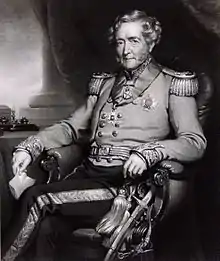John Bell (British Army officer)
General Sir John Bell GCB (1 January 1782 – 20 November 1876)[1] was a British soldier and magistrate. At the time of his death, he was the senior general of the British Army.
Sir John Bell | |
|---|---|
 Portrait commissioned by Island of Guernsey | |
| Born | 1 January 1782 St Andrews, Fife |
| Died | 20 November 1876 (aged 94) Belgravia, London |
| Allegiance | |
| Service/ | |
| Rank | General |
| Battles/wars | Peninsular War Anglo-American War |
| Awards | Knight Grand Cross of the Order of the Bath |
Background
Born at Bonytoun in the county of Fife, he was the son of David Bell and Janet Duncan.[1] After attending Dundee Academy, he worked first as a merchant and in 1805 entered the British Army as an ensign of the 52nd (Oxfordshire) Regiment of Foot.[1] Bell was known as a witty raconteur, and gifted artist and draughtsman. [2]
Career
He went to Sicily a year later and subsequently took part in the Peninsular War until 1814.[3] During this time, he was decorated with the Army Silver Medal with six clasps and received the Army Gold Cross.[3] Bell was wounded in the Battle of Vimeiro in 1808 and was in the war's last years assistant quartermaster-general.[1] In December 1814, he was transferred with his regiment to the United States and was involved in the Anglo-American War until the beginning of the following year.[1] After his return to England, he was awarded a Companion of the Order of the Bath.[4]
Bell was sent to the Cape of Good Hope as deputy quartermaster-general in 1821[5] and served as chief secretary to the colony's government from 1828.[6] At that time his nephew Charles Davidson Bell held the post of Surveyor-General in the Cape Colony. He was appointed an aide-de-camp to King William IV of the United Kingdom in 1831 and was promoted to major-general in 1841.[3] He joined the board of general officers in 1847 and was nominated Lieutenant Governor of Guernsey in the following year, holding that office until 1854.[3]
Bell took command of the 95th (Derbyshire) Regiment of Foot in 1850[7] and became a lieutenant-general in 1851.[8] A year later, he was advanced to a Knight Commander of the Bath.[9] In 1853, he received colonelship of the 4th (The King's Own) Regiment of Foot,[10] a command he held until his death in 1876.[11] Bell was further honoured with the Order's Grand Cross in the 1860 Birthday Honours[12] and was promoted to general in June.[13]
Family
In 1821, he married Catherine, eldest daughter of James Harris, 1st Earl of Malmesbury.[6] His wife was born in St Petersburg and a godchild of Empress Catherine I of Russia.[1] She died at Upper Hyde Park Street in London in 1855.[14] Bell survived her until 1876, when he died, aged 92, at Cadogan Place.[1] He was interred on Kensal Green Cemetery.[1]
References
| Wikisource has the text of the 1885–1900 Dictionary of National Biography's article about John Bell (1782-1876). |
- Boase, George Clement (1885). . In Stephen, Leslie (ed.). Dictionary of National Biography. 4. London: Smith, Elder & Co. p. 170.
- "The Life and Work of Charles Bell" - Phillida Brooke Simons (Fernwood Press, 1998)
- Dod, Robert P. (1865). The Peerage, Baronetage and Knightage of Great Britain and Ireland. London: Whitaker and Co. pp. 112–113.
- "No. 17061". The London Gazette. 16 September 1815. p. 1880.
- "No. 17703". The London Gazette. 5 May 1821. p. 977.
- Walford, Edward (1860). The County Families of the United Kingdom. London: Robert Hardwicke. pp. 44.
- "No. 21109". The London Gazette. 28 June 1850. p. 1812.
- "No. 21262". The London Gazette. 11 November 1851. p. 2965.
- "No. 21307". The London Gazette. 6 April 1852. p. 988.
- "No. 21507". The London Gazette. 30 December 1853. p. 3817.
- "No. 24389". The London Gazette. 1 December 1876. p. 6684.
- "No. 22387". The London Gazette. 18 May 1860. p. 1915.
- "No. 22400". The London Gazette. 3 July 1860. p. 2497.
- The Annual Register 1856. London: F. & J. Rivington. 1856. pp. 333.
| Government offices | ||
|---|---|---|
| Preceded by Sir William Napier |
Lieutenant Governor of Guernsey 1848–1854 |
Succeeded by Sir William Knollys |
| Military offices | ||
| Preceded by Sir Richard Armstrong |
Colonel of the 95th (Derbyshire) Regiment of Foot 1850–1853 |
Succeeded by Sir Francis Cockburn |
| Preceded by Sir Thomas Bradford |
Colonel of the 4th (The King's Own) Regiment of Foot 1853–1876 |
Succeeded by Studholme John Hodgson |